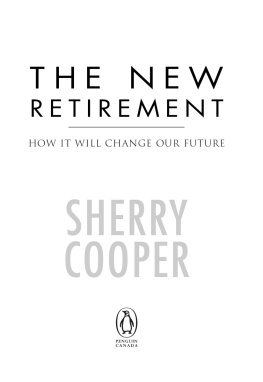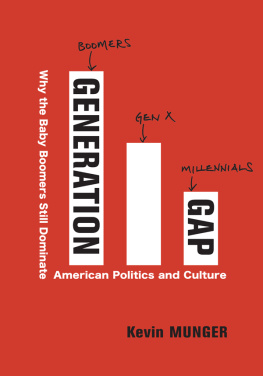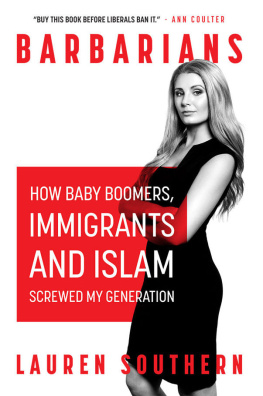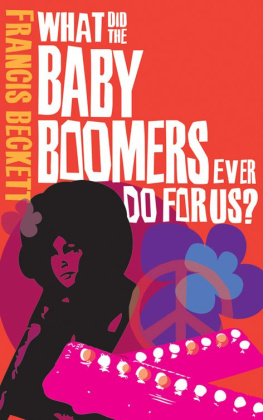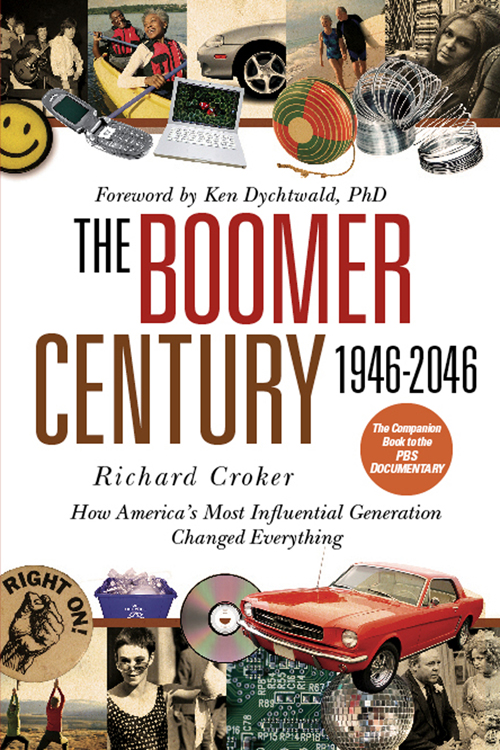Copyright 2007 by Alexandria Productions, Inc.
All rights reserved. Except as permitted under the U.S. Copyright Act of 1976, no part of this publication may be reproduced, distributed, or transmitted in any form or by any means, or stored in a database or retrieval system, without the prior written permission of the publisher.
Springboard Press
Hachette Book Group
237 Park Avenue, New York, NY 10017
Visit our website at www.HachetteBookGroup.com.
First eBook Edition: April 2009
ISBN: 978-0-446-56142-6
Springboard Press is an imprint of Warner Books, Inc. The Springboard name and logo are trademarks of Hachette Book Group USA.
As always,
for Terry and Amanda
Also for former United States Congressman
and Georgia Supreme Court Chief Justice
Charles Longstreet Weltner,
who took a very young boomer
under his wing and taught him the meaning of
Moral Courage
F or nearly thirty-five years, I have been studying the psychological, social, and marketplace evolution of the baby boom generation. It is my passion, my vocation, and, not coincidentally, my own generation. I have written twelve books about or related to boomers, and I have spoken to audiences totaling two million people. But for a long time, I have dreamed of transforming my theories about this generation into a television documentary. The PBS special The Boomer Century 19462046 is the realization of that dream, and I couldnt be any more proud of the program. Thanks to the generous sponsorship of the Vanguard Group, we were able to produce a thoughtful and comprehensive documentary about the past, present, and future of this incredibly complex generation. However, as we started production, it quickly became apparent that there was far more information and opinion being gathered, and far more that we wanted to say, than the allotted time would permit. So it became obvious that this book was necessary for us to do full justice to the subject.
It has often been said (frequently by myself) that American baby boomers are the most studied generation in history. You are about to meet the students. Many of the people we have brought together have devoted decades to understanding the impact of this gigantic cohort on the history, social structure, and economy of our nation.
Even with all the study I have done on the subject of this generation, it was fascinating for us to interview such a diverse group. In many cases my research and beliefs were confirmed, but in many others I encountered some challenging and fascinating differing views.
My father never went to college, and he used to say to me, I want you to get educated so you can see that there are two sides to every story. A few years ago I told my father it didnt quite work out that way. The more educated I seem to get, I said, the more I realize there are not two sides to every storythere are a thousand sides to every story.
This book contains many sides of the boomer story.
I am often asked by people older and younger than the boomers why we think we are so important. We are often accused of being a self-centered, narcissistic me generation. But the truth is, we are important because there are just so many of us. It is the phenomenon often metaphorically referred to as the pig in the python, as this gigantic bulge in the population moves from one stage of life to another. It is because of our numbers that we have overwhelmed every institution along the way. That is one of the key reasons our generation is so important, but what make us particularly interesting are our collective characteristics.
Generalizations are always tricky, and all individuals within a generation are certainly not alike. But it is possible to find characteristics that are shared by enough of a cohort and, to a degree, not found in previous or subsequent generations. Baby boomers are famously antiauthoritarian and idealistic. We also tend to be innovative and self-empowered. Our impact on this nation has been, and will continue to be, measured in terms of both quantity and quality.
But how did we come by those uniquely boomer qualities? That answer will be found in our amazing history and the extraordinary decades of our childhood and adolescence. The peace and prosperity of the fifties gave way to the angst of the sixties and seventies. Television replaced radio; Bob Dylan replaced Perry Como; and civil rights and antiwar demonstrations replaced World War II victory parades. A bomb exploded in Birmingham, and shots were fired in Dallas, Memphis, Los Angeles, and at Kent State. Men walked on the moon, and the daughters of Rosie the Riveter demanded to be more than June Cleaver could have ever imagined being. We came to realize that our planet was fragile and should be handled with care.
But my deeper interest has always been in the second half of life. Who will we become next? What will we look and feel like when were seventy? When were ninety? How does the world need to be redesigned for our aging bodies? What will we do with the new longevity that science and better living have promised us? Will we simply get entitlements and have a leisurely stroll through the rest of our lives? Or will we use that time to give back, to achieve a state of wisdom, to heal, and, perhaps, to transform the world?
I believe this generation is going to radically redo aging, just as weve changed every other stage of life and institution weve encountered: the way we look, the way we feel, what it means to be sixty, what it means to be ninety, the nature of friendships and relationships in maturity, how long well work, who pays, what we might blossom into when were eighty versus what we thought we were going to be when we were twenty. The whole landscape and mindscape of adulthood are about to be totally and dramatically altered. All this time, weve just been warming up for the big game.
These issues and more will be addressed in this book by some of the sharpest minds and most original thinkers of our time. I know you will be challenged, enthralled, and entertained by The Boomer Century 19462046. I know I am.
Ken Dychtwald, PhD
T he Boomer Centuryboth the television documentary and the bookare about the largest and most closely observed generation of Americans in history. Born between 1946 and 1964, boomers have been glamorized and reviled, applauded for their idealism and attacked for their materialism, praised for their innovation and condemned for their rebelliousness.
Whichever of those characterizations may be correct, these seventy-eight million Americans have changed the worldthey are changing the worldand they will continue to do so for another twenty, thirty, or forty years to come.
The early chapters of this book are perhaps the most fun, for they are pure nostalgia. From Ricky Nelson to Richard Nixon, we will remember the birth and death of idealism. The middle chapters may be the most challenging, for they are about those days in the middle of our lives when we somehow evolved from flower childrenemblems of peace, love, and happinessinto the me generation, set out on a quest for the best and the most. While he wasnt a boomer by definition, Jerry Rubin came to exemplify this bizarre transformation. He went from being one of the infamous Chicago Seven, parading in front of Judge Julius Hoffmans bench saluting and shouting Heil Hitler, to a Wall Street stockbroker. And the final chapters, undoubtedly the most important, perhaps should have been written in Nostradamus-style quatrains, for they predict the future, and it is there, in the next quarter century, that boomers may face their most challenging years and have their greatest impact, for better or for worse, as they begin to experience life after sixty.


